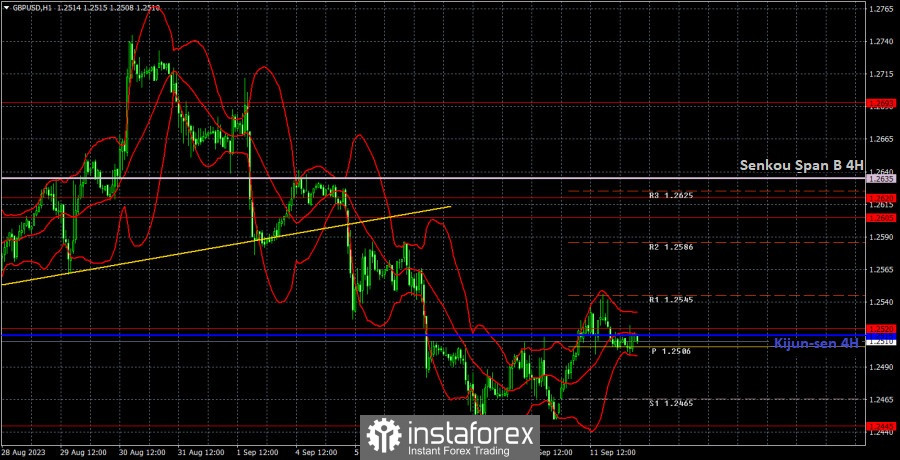Analysis of GBP/USD 5M

On Monday, GBP/USD showed quite interesting movements, mostly during the night. With the opening of the European trading session, the price reached the 1.2520-1.2537 range, and the pair just traded around that range until the end of the day. For most of the daytime, we witnessed a flat, as we warned on Monday morning. There were no economic reports or fundamental events. There was supposed to be a speech by Bank of England Chief Economist Huw Pill, but there is still no information available on that. But judging by the pair's movements, even if the speech did take place, Pill did not reveal anything important. Moreover, the market is already familiar with his opinion on interest rates. Pill supports keeping rates at a high level for an extended period, rather than further tightening.
It's very difficult to highlight any trading signals. Before the opening of the US trading session, the price fell below the designated range, but it only managed to move by about 10 pips. It was not possible to set a Stop Loss for this trade, but there was no reason to close it before the end of the day either, as there were no buy signals. In the end, traders could have closed the short position anywhere and they likely incurred a small loss, although the price ultimately returned to the point of formation at the end of the day.
COT report:

According to the latest report, the non-commercial group of traders closed 900 long positions and opened 9,800 short ones. Thus, the net position of non-commercial traders decreased by 10,700 positions in a week. The net position has been steadily growing over the past 11 months as well as the pound sterling. Now, the net position has advanced markedly. This is why the pair will hardly maintain its bullish momentum. I believe that a long and protracted downward movement should begin. COT reports signal a slight growth of the British currency but it will not be able to rise in the long term. There are no drivers for opening new long positions. Sell signals are starting to appear on the 4-hour and 24-hour charts.
The British currency has already grown by a total of 2,800 pips, from its absolute lows reached last year, which is a significant increase. Without a bearish correction, the continuation of the uptrend will be illogical. We are not against the uptrend; we just believe a solid correction is needed first. The market perceives the fundamental background one-sidedly, ignoring any data in favor of the dollar. The Non-commercial group of traders has a total of 97,000 long positions and 48,700 short ones. I remain skeptical about the long-term growth of the pound sterling, and the market has recently started to pay more attention to selling.
Analysis of GBP/USD 1H

On the 1H chart, GBP/USD has settled below the ascending trendline, which shows that the pair may extend its downward movement. The price is also below the Ichimoku indicator lines. The pound is expected to fall, but it is gradually doing so. Fortunately, the pair has plenty of time to fall further.
On September 12, traders should pay attention to the following key levels: 1.2269, 1.2349, 1.2429-1.2445, 1.2520, 1.2605-1.2620, 1.2693, 1.2786, 1.2863. Senkou Span B (1.2635) and Kijun-sen (1.2515) lines can also be sources of signals, e.g. rebounds and breakout of these levels and lines. It is recommended to set the Stop Loss orders at the breakeven level when the price moves in the right direction by 20 pips. The lines of the Ichimoku indicator can move during the day, which should be taken into account when determining trading signals. There are support and resistance levels that can be used to lock in profits.
Today, there are no important events lined up in the United States. However, traders may look to the release of UK reports on unemployment rate, jobless claims, and wage growth figures, which will be published in an hour. They are not that important, but it's better than nothing. Today, the pound may trade more actively than the euro.
Description of the chart:
Support and resistance levels are thick red lines near which the trend may end. They do not provide trading signals;
The Kijun-sen and Senkou Span B lines are the lines of the Ichimoku indicator, plotted to the 1H timeframe from the 4H one. They provide trading signals;
Extreme levels are thin red lines from which the price bounced earlier. They provide trading signals;
Yellow lines are trend lines, trend channels, and any other technical patterns;
Indicator 1 on the COT charts is the net position size for each category of traders;
Indicator 2 on the COT charts is the net position size for the Non-commercial group.





















